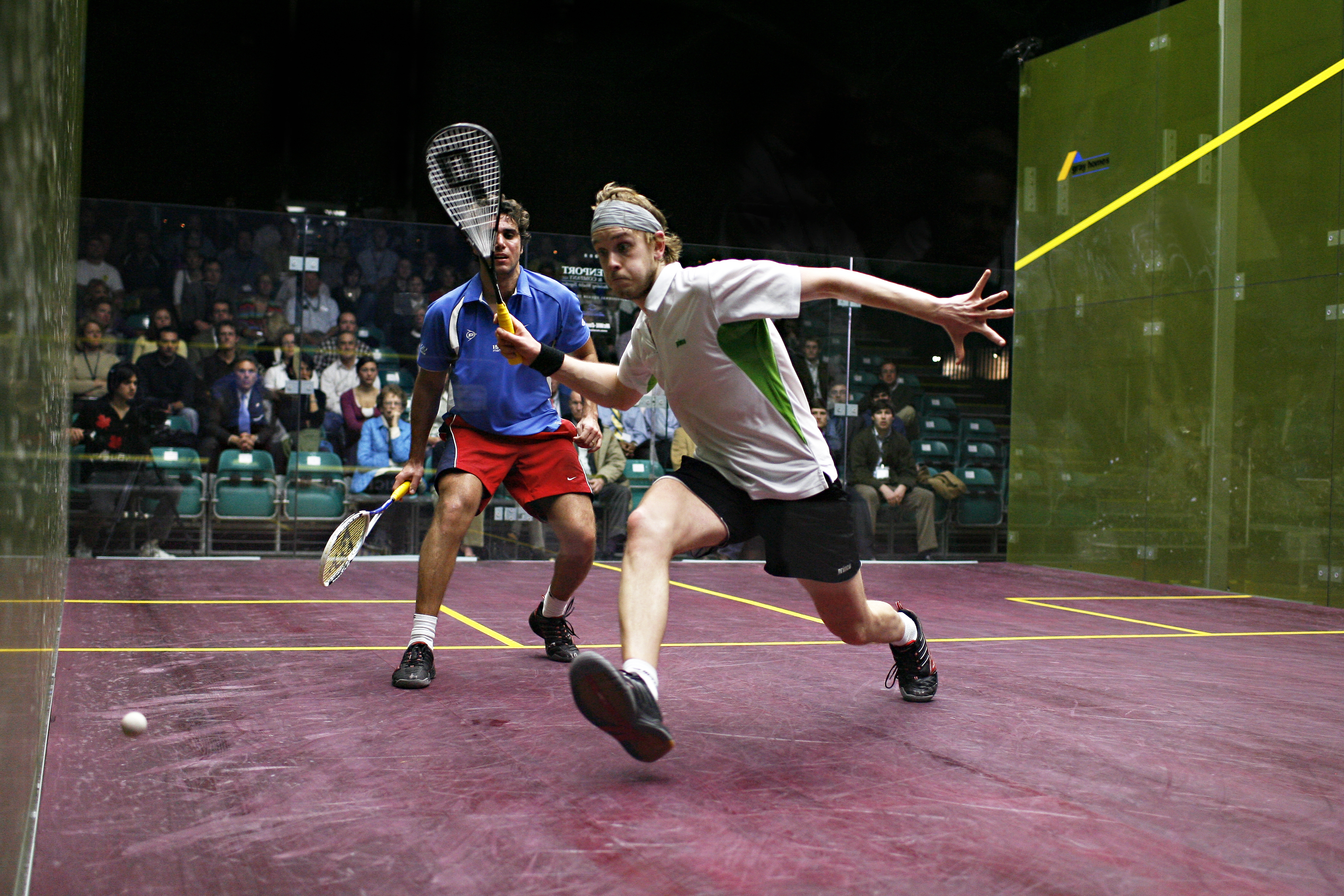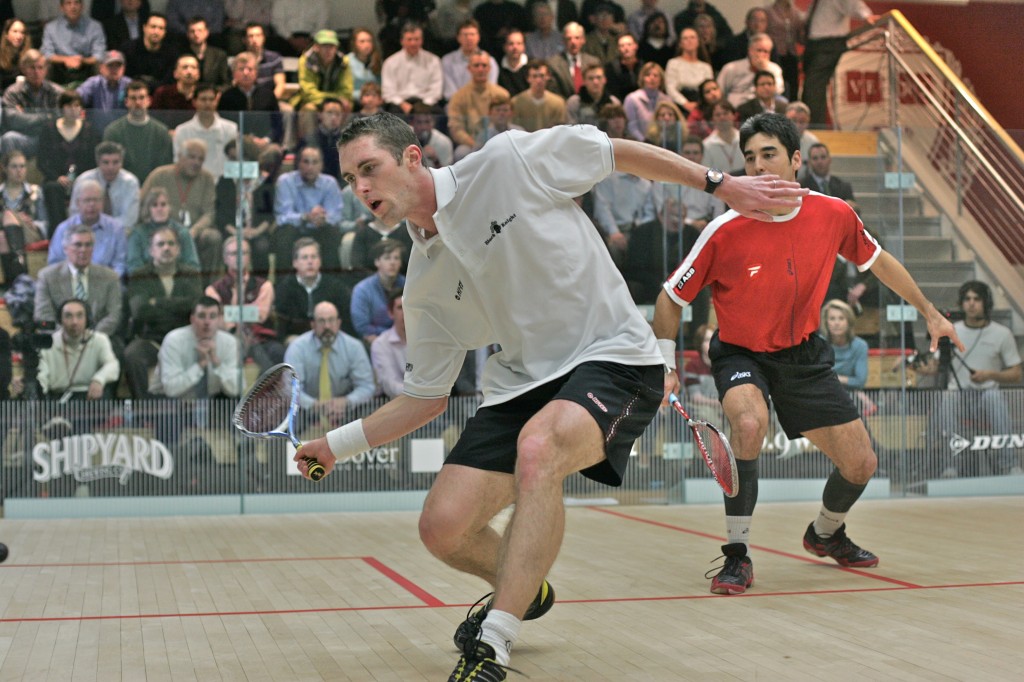
By James Zug
In the summer of 1989 Tom Jones and his wife Hazel White Jones, the publisher and editor of Squash News—this magazine’s predecessor—cobbled together a coterie of seven small pro softball tournaments under the umbrella of the Grand Prix circuit. Thirty-seven pros from 15 countries played in the Grand Prix that first year and the idea took off. By 1995 the summer had stretched to 23 Grand Prix tournaments in 21 of the 36 USSRA districts.
The Grand Prix was a fantastic proving ground for younger players: Jonathon Power played in six events in his first full year as a pro in 1991; Jamie Crombie won at least one Grand Prix tournament eight consecutive years; and Anthony Hill learned the power of planning, as he landed at JFK airport on Memorial Day Weekend in 1989 without cash or a credit card and spent two nights at the airport waiting for the banks to reopen.
In 2008 John Nimick organized a new, refurbished version of the Grand Prix. A US Squash Hall of Famer and former PSA Executive Director, Nimick had long hoped to recreate a Grand Prix-type circuit and to add a few twists. The 2008 Players Cup tournaments were not the small, one-star types like the Grand Prix (the 1992 summer’s 19 tournaments totaled $100,000 in prize money) but an elite clutch of established, PSA-sanctioned, five-star tournaments that attracted the world’s top players. In seven weeks, five biggies (two were promoted by Nimick himself) rolled past like a churning caravan: the $82,500 Bear Stearns Tournament of Champions; the $50,000 EBS Dayton Open; the $60,000 PACE Canadian Classic; the $50,000 Evergreen Oregon Open and the $77,500 Davenport Pro Championships in Richmond, Virginia. With the compressed schedule and a total prize money of $320,000, many of the highest-ranked pros camped out in North America all winter.
The seductive Nimick then added a culminating playoff—the McWil Courtwall Players Cup Championship. It was an eight-man, non-ranking event. With the return of the US Open to New York, Nimick was able to continue Boston’s streak of hosting a major pro tournament to 10 straight years by hosting this brand-new invitational. It had a $50,000 purse, but Nimick made more news by changing the usual pattern of payout and handed the winner $25,000—the largest first-place check in North American squash history.
A concise, distinct Players Cup circuit not only gave shape to the winter season. Squash video king Jean Delierre of Telimage Productions partnered with Nimick to shoot the circuit. Matches were streamed live with witty commentary at www.squashlive.com. Equally importantly, Delierre produced a high-definition television package that will appear later this year on the Tennis Channel in the US, on TSN in Canada and abroad on PSA-affliated networks like Sky-TV.
Ramy Keeps Pace
Hot on the heels of countryman Amr Shabana’s World No. 1 ranking, Ramy Ashour steamrolls to PACE Canadian Classic Title
By Luigi Benetton
After a Thursday night match, Amr Shabana smirked as he suggested that tournament organizers pack up the PACE Canadian Squash Classic and ship it to Cairo.
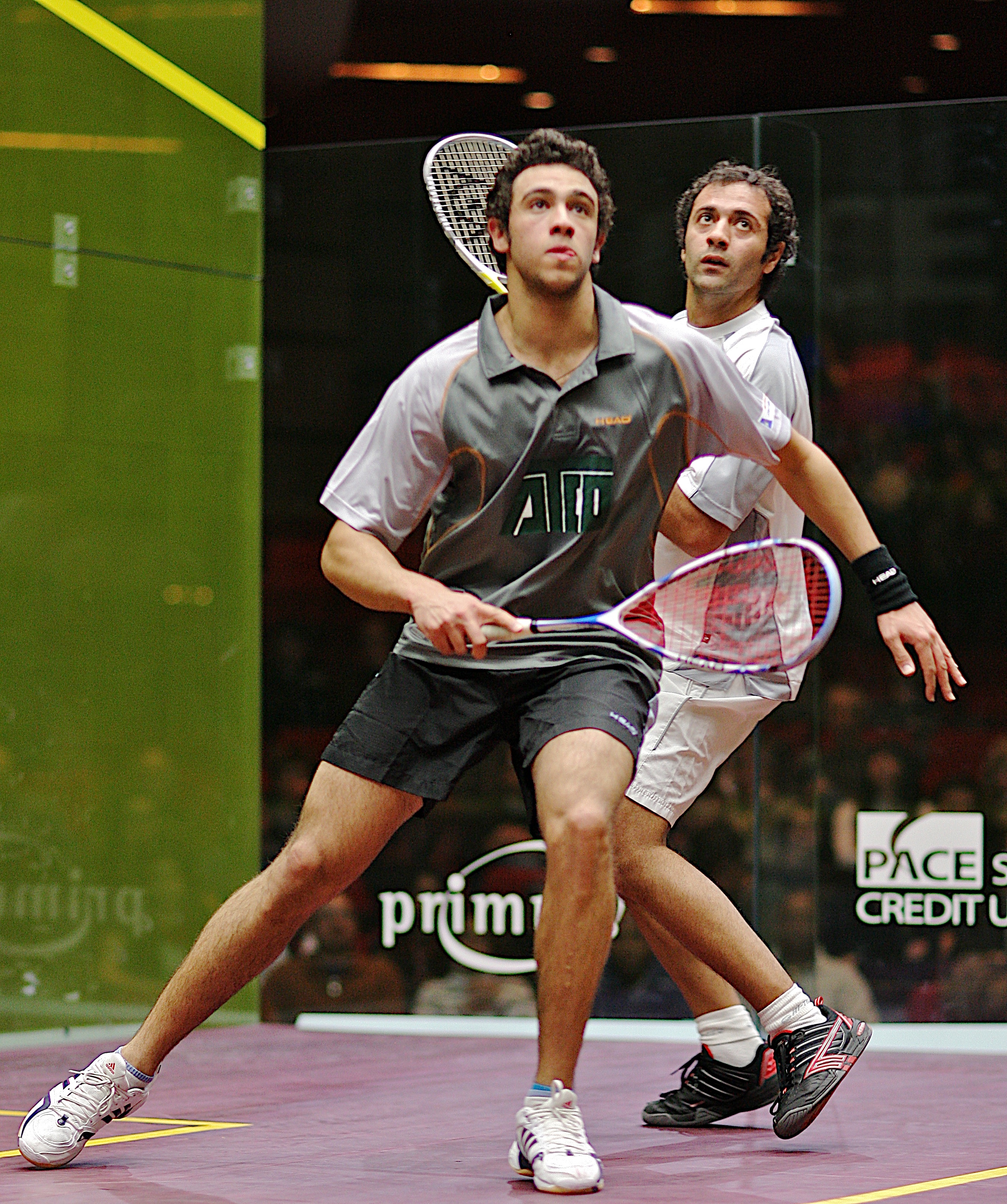
Fans could easily forgive him this comment. Every member of the highly ranked Egyptian contingent brought his A-game and squash fans enjoyed fantastic matches from all the players throughout the Toronto tournament, held in the John Bassett Theatre of the Metro Toronto Convention Centre.
The Canadians who made the round of 16 did as well as could be expected. Qualifier Matthew Giuffre accepted a brusque welcome to his first home tournament, falling 11-4, 11-9, 11-7 in a 29-minute loss to World No. 1 Shabana.
Giuffre betrayed an “awe-shucks” demeanor after the match. “It’s awesome playing the best there is in the sport,” said the Edmonton, Alberta-based player. “I don’t get that level of play at home.”
Giuffre had played Jonathon Power “back in the day.” Comparing the two, he noted that Power attacked more and hit the ball harder, while Shabana is more accurate.
Shabana showed little rust in his first tournament back after recovering from a wrist ailment. “It feels good to come back with a win,” he said. “I took four weeks off after the World Open and started training mid-January.”
While Shawn Delierre suffered an equally quick 33-minute defeat (11-7, 11-8, 11-4) to World No. 5 Wael El Hindi, Shahier Razik managed an unusually long straight-games win over Colombian Miguel Rodriguez.
Neither Razik nor Rodriguez gave an inch during rallies that turned into battles of attrition. The difference? Rodriguez tinned the final four points in the second game and final three in the third to end a memorable, lung-busting 46-minute Razik victory, 11-8, 11-8, 11-7.
Indicative of the match to come, World No. 2 and 2007 PACE champion Ramy Ashour seemed to toy with qualifier Jan Koukal on the first point, rallying patiently down the left wall until the ball left the wall by just enough of a margin for an opposite corner kill shot. Koukal fought to keep pace, and thanks to some Ashour errors pulled close, but he yielded game one 11-9. Ongoing determination from the Czech did little to check his Egyptian rival’s romp to a 30-minute 11-9, 11-7, 11-6 victory.
Closing out round-of-16 action were the Australian duo of David Palmer and Cameron Pilley. After an uncharacteristically lackluster start from Palmer, last year’s PACE finalist, he left the court early in game two for a quick bout with a physiotherapist.
Down two games, Palmer gritted his teeth and turned game three into the best of the evening, if not the tournament. Palmer seemed to draw strength from annoyance at calls from the ref he didn’t like. Pilley mercilessly went to the front left corner, but Palmer retrieved whatever he had to during the 32-minute game to eke it out 16-14. Palmer’s heroism finally evaporated at the left side of the court in the fourth game, and after 72 minutes Pilley moved on to the quarters, 11-5, 11-5, 14-16, 11-4.
After the match, when asked if it was wise to carry on, Palmer matter-of-factly admitted “Probably not, but I just don’t like to lose.” Palmer also listed the hours he spent with a physiotherapist that day to prepare for the match. In the end, his left hip would not cooperate. “I just need a couple days of good physio and good work,” Palmer said, adding that he hoped to play in Portland the following week.
Thursday night at the John Bassett Theatre began with Egyptian Karim Darwish’s workmanlike takedown of Australian Stewart Boswell in 37 minutes (11-6, 11-7, 11-0). Then Ashour continued his trot through the draw against Razik. When asked what he would do differently the next time he faced Ashour, Razik said he would drink a cup of coffee before the match so he wouldn’t sleep through a disheartening 4-minute 11-1 first game. “You have to be alert against him,” said Razik of his Egyptian opponent after losing 11-1, 11-8, 11-7 in 34 minutes.
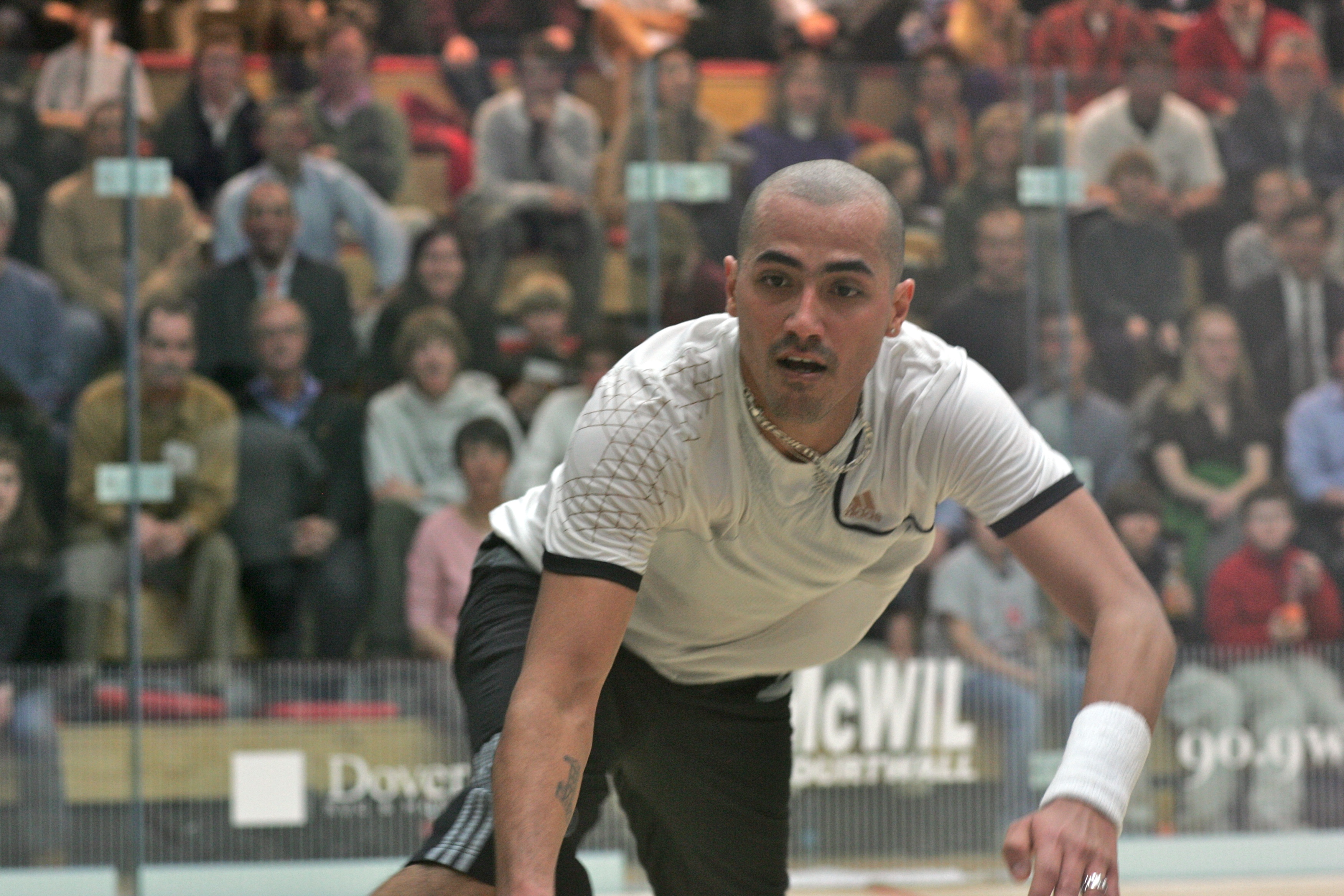
The one-Egyptian-per-match theme of the evening continued as El Hindi faced off against Pilley. In the third game, having taken the first two, El Hindi seemed to lose steam and turned what was an entertaining battle of attrition into a three-let-per-point shuffle. El Hindi refocused in game four to earn his ticket to the semifinals with an 11-5, 11-7, 8-11, 11-5 win (76 minutes).
Then the fourth and fifth Egyptian competitors of the evening took the court. Shabana, the 2006 Pace champion, faced Mohammed Abbas. A first-game duel went to 15-13 in Shabana’s favor, then Shabana powered his way to an 11-5 game two win.
Not yet ready to concede, Abbas came from behind to take game three 11-9, the winning shot being a length nick off the back wall that not even Shabana could dig. However, several shots appeared to dismay Abbas during the game, and trailing Shabana 5-0 in game four, he retired. Once backstage, he promptly popped off his shoe to relieve the pressure it exerted on his tender foot.
Thursday night’s quarterfinals were 62.5 percent Egyptian. That figure rose to 100 percent for Friday’s semis. Emboldened, Egypt’s ambassador to Canada told the audience that his country, eager to challenge Canada in other sports, was assembling a hockey team.
Ashour and Darwish played first. As always, Ashour was happy to attack early, often and accurately, shooting fearlessly for corners while matching length shots from Darwish.
Down two games, Darwish paused game three to discuss a shot with his younger countryman, then managed to take the game. Ashour stormed off the court in disgust, then stormed back to win the match 11-4, 11-7, 8-11, 11-5, in 51 minutes. The finishing touch being a hard yet accurate serve return into the opposite front corner.
That shot proved a favorite for all the Egyptians Friday night. Both El Hindi and Shabana used it in their first game. Game two saw more thrust, parry and trademark Shabana denial of lobs whenever El Hindi tried to take advantage of his shorter stature. Shabana took that game as well and set up the final expected between himself and Ashour with an 11-9, 11-9, 4-11, 11-7 victory in 60 minutes.
Shabana started Saturday night’s final against Ashour much like Razik did two nights earlier, losing the first game 11-2 in little more than 4 minutes.
He must have had a caffeine jolt during the intermission. After trading points to start game two, Shabana fed Ashour some of his own medicine, using quick low shots and several deceptions to run up a 6-1 lead. Not to be outdone, Ashour promptly tied the game and finished it 11-8.
The “coffee” really took effect in game three. Several times, Shabana deceived his 20-year-old compatriot using the same type of creativity Ashour relies on to take the third game. The two fought on but Ashour ran up a 7-3 lead in game four. Shabana managed to fight back and went back to his creative shots, but Ashour took game four and his second straight PACE Canadian Squash Classic in 38 minutes, 11-2, 11-8, 8-11, 11-7.
“I expect big things from the big boy,” Shabana prophetically quipped earlier in the tournament. “He is a tremendous player and he has so much passion for this sport. He loves it.”
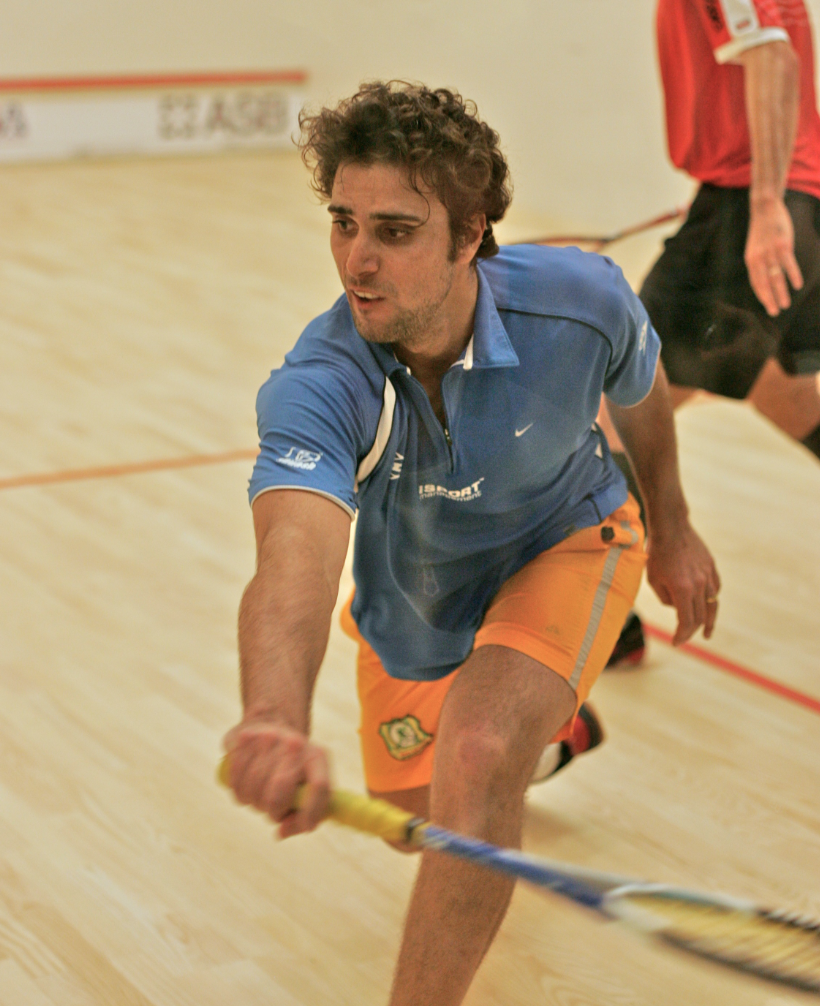
OREGON OPEN
In the fourth stop on the Players Cup Circuit Squash tour, the Oregon Open offered a unique five-star event for its players and spectators alike. On the court, Egyptian Karim Darwish secured his first win on the mini tour by holding off Thierry Lincou of France in four games.
But it was the evolution of the Oregon Open that afforded an experience different from all the rest. While most five-star events are run by tournament promoters trying to pamper players, generate sponsorships to increase prize money and sell lots of tickets, the Oregon Open was born to build exposure for the sport in the Pacific Northwest while generating increased prize money year after year. Part of the process was to connect the Oregon Open with a regional amateur event, and this year the amateurs were playing in skill level divisions with the winners having their entry fees to the U.S. Skill Level Championships waived. And while securing sponsorships is critical for the event, the Oregon Open takes the approach of getting the Portland community more involved.
As such, over 110 local businesses, Multnomah Athletic Club (MAC) members, individuals within the community and ticket sales raised the 2008 championship to five-star PSA status.
For the players, posh hotels are exchanged for billeting arrangements with MAC members. Families open their homes to the players and, during the week, they invest their time taking the players to places in the Portland area that they’d like to see. For some, it was Mt. Hood; for others, the Oregon coast.
Most of all, the Oregon Open seeks to create interest among children who don’t currently play squash. On a Junior Appreciation Day, any MAC junior could bring up to two guests for free clinics. Nearly 30 youngsters watched, got excited and immediately picked up a racquet for the first time. And the players were phenomenal in helping all of them gain an interest in the game—the future of the sport.
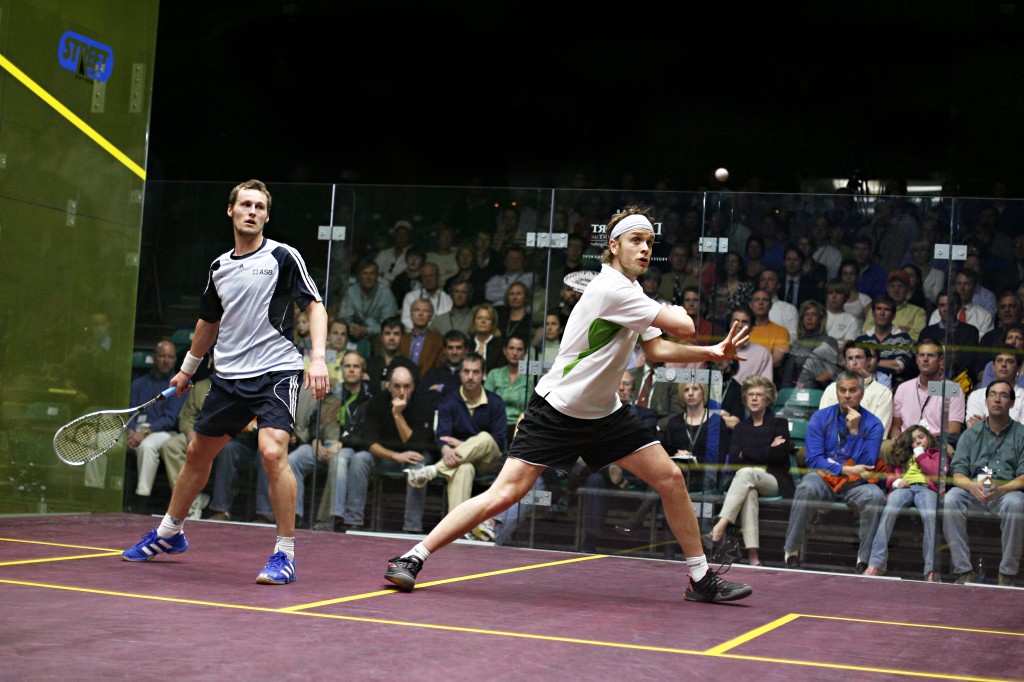
DAVENPORT VIRGINIA OPEN
By James Zug
Richmond’s contribution to the 2008 Players Cup would have been unimaginable half a decade ago. In 2004 Gus Cook hosted a pro tournament at the Country Club of Virginia within weeks of starting his job as squash pro. It was a one-star, $10,000 event; the next year it was two-stars and $20,000. In 2006 Cook moved the tournament down the road to the home of the Spiders, the University of Richmond. For the next two years, the tournament had a glass court beautifully plopped down in the Tyler Haynes Commons, UR’s student union which had 50-foot high windows looking out on the tree-banked pond. In 2006 it was three-stars and $30,000; in 2007 it was five stars and $50,000.
In 2008 the Davenport Professional Squash Championship was beyond the stars, a Super Series Silver tournament (only squash promoters have the astrological acumen to understand the PSA’s ranking levels) with one of the largest prize money purses in the country and 12 of the world’s top 20 players. Cook moved his McWil Courtwall portable court up the hill to UR’s elderly Millhiser Gym. It had a 400-seat capacity and a cozy atmosphere with wooden rafters criss-crossing over the court. In an innovation, Cook sold the back-wall tickets for the entire week in one package (the bleachers had a color-coded map) rather than for specific days.
The opening round, spread over two nights, provided more of the week’s fireworks than most tournaments. Patrick Chifunda, the Zambia zepher, is now based at CCV and running junior clinics all over town. So when he took on Cameron Pilley, he received enormous home-crowd ovations—at introductions, after the warm-up, after some of his airborne swan dives and after his match, which he lost in three.

Julian Illingworth continued his annus mirabilis and again reached the second round of a major tournament. He did a full tilt boogie-woogie dance over Hisham Ashour. There were two key moments in the 3-1 victory: in the second game, Illingworth saved three game balls to win in a tiebreaker 15-13; in the fourth game, after tripping badly in the third, Illingworth glided from a 3-6 deficit to a 11-7 win. He wonderfully waltzed with Ashour’s younger brother Ramy in the next round, losing 3-0 but taking the last two games into overtime.
The next two rounds produced banner headlines. In the second round David Palmer went out badly to Olli Tuominen, 3-1, taking a conduct warning and a glancing blow to his crotch at the end of the third game from Tuominen’s backswinging racquet; and Mohammed Abbas wasted three match balls in the third game versus Thierry Lincou and lost in five. In the quarters Ramy Ashour, drained from 22 straight days of squash (some of it was highpaying exhibitions, so hold off on the violins), lost to Karim Darwish 11-8 in the fifth; and Wael El Hindi, permanently affixed the word “mercurial” next to his name after disputing a call down 0-4 in the third and tanking the rest of the game, deliberately returning serves into the overhead lights.
The finals, James Willstrop v. Gregory Gaultier, was an 80-minute beaut: accurate volleying, jack-rabbit creativity, flagrant risk-taking and more winners than errors. It went to five. Willstrop shot to a 5-0 lead in the fifth and then poked it out to win 11-4. He is looking like he has moved from being the youthful upstart to the man-in-his-prime.
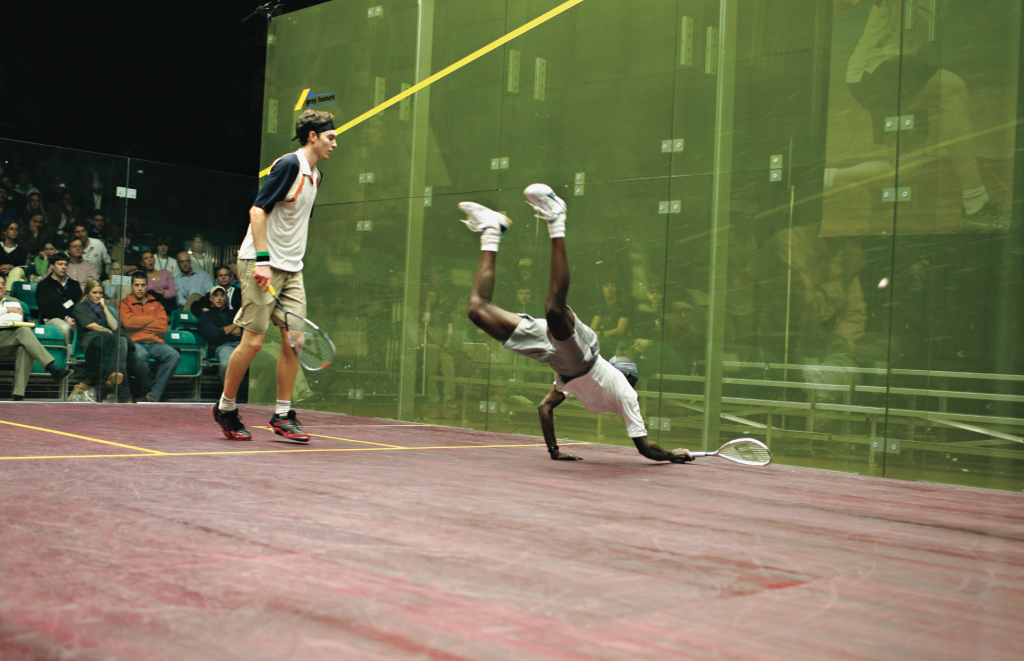
McWil Courtwall Player’s Cup Championships
By James Zug
The McWil Courtwall Players Cup Championship took place at the Murr Center at Harvard, which has a permanent four-wall glass court. It was the first time Harvard had been the primary host of a pro tournament since the 1970s when the Boston Open was played at Hemenway, the old and venerable squash gym at the law school. It was great to hear the whaoompff and thwack of the pros smashing balls back on the Crimson campus, although it was more a thwomp when you bounced the basketball-sized inflatable Dunlop squash ball that was on offer at Murr.
The sounds were wonderful, but the word “withdrew” was too often bantered about during the week, for a number of players seemingly did not want to risk exacerbating injury in a non-ranking tournament, no matter how much money was on the line.
For American fans, it started off perfectly. The small qualifying draw went superbly. Chris Gordon toppled Yasser El Halaby, and then, when John White withdrew due to the stomach flu, he found a place in the main draw. Gordon put up a spirited, high-quality three-game fight against James Willstrop, even holding two game balls in the first game. Julian Illingworth also did well in the qualies. Very much looking like his world ranking is more than justified, he repeated his result over Hisham Ashour in Richmond nine days earlier and took out Ashour in three tight games.
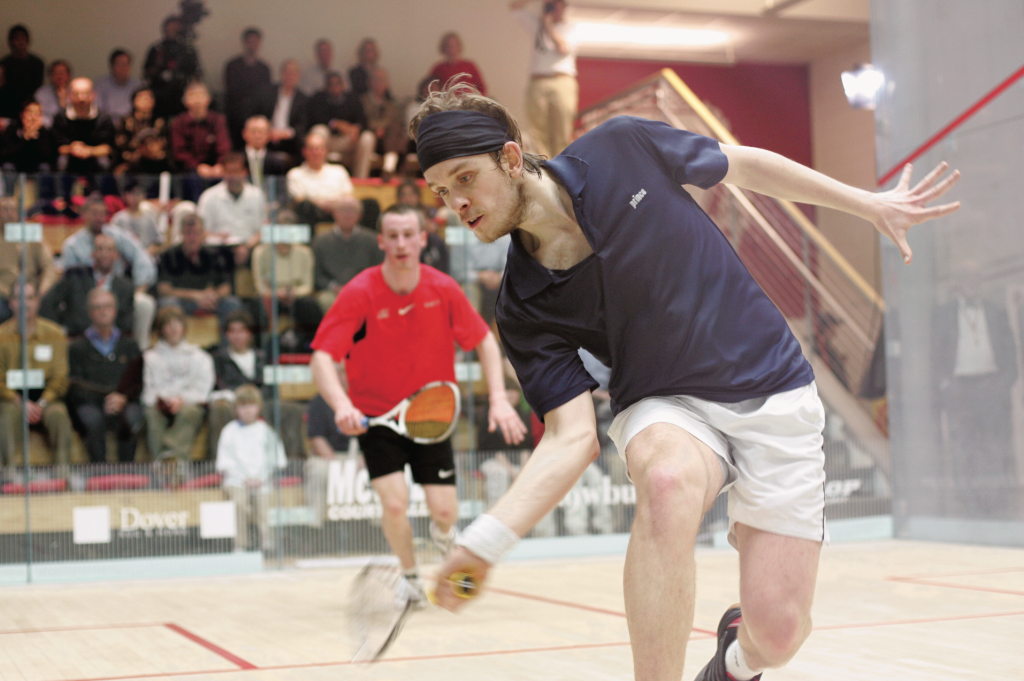
Illingworth’s victory was Pyrrhic, as he had turned his ankle on match point and withdrew before his first-round match. Ashour, the lucky loser, replaced him in the main draw.
It got worse. Mohammed Abbas then withdrew in the third game of his first-round match, after he slipped on the court and sprained his ankle. Then after Karim Darwish and Wael El Hindi put up a Cairo derby of epic proportions—11-9 in the fifth— Darwish withdrew with a bad back. With no more players in the arsenal, Nimick got Willstrop to agree to an exhibition with Chris Gordon and so for a half hour the two men reprised their match from the night before.
To sum up: Two ankles, one back and one stomach bug. Should we change the name to the Doctors Cup?
The luster was still there on the night of the finals. It was a jammed, standing-room-only crowd. I snagged a seat in the aisle, right next to Frank Millet, the Milton coach who has followed professional squash in Boston for the past 70 years. As the undercard, Nimick staged another lightning, no-lets draw, with a pile of cash in unmarked bills placed in a bag at the front wall. Seven Boston-area teaching pros and coaches and Peter Nicol were in the draw. (The pros had their club’s initials next to their name, Nicol had M.B.E. next to his—just wait until he gets knighted.) Nicol topped Harvard’s Colin West in the one-point final and then rushed to the commentating table and put on his headphones.
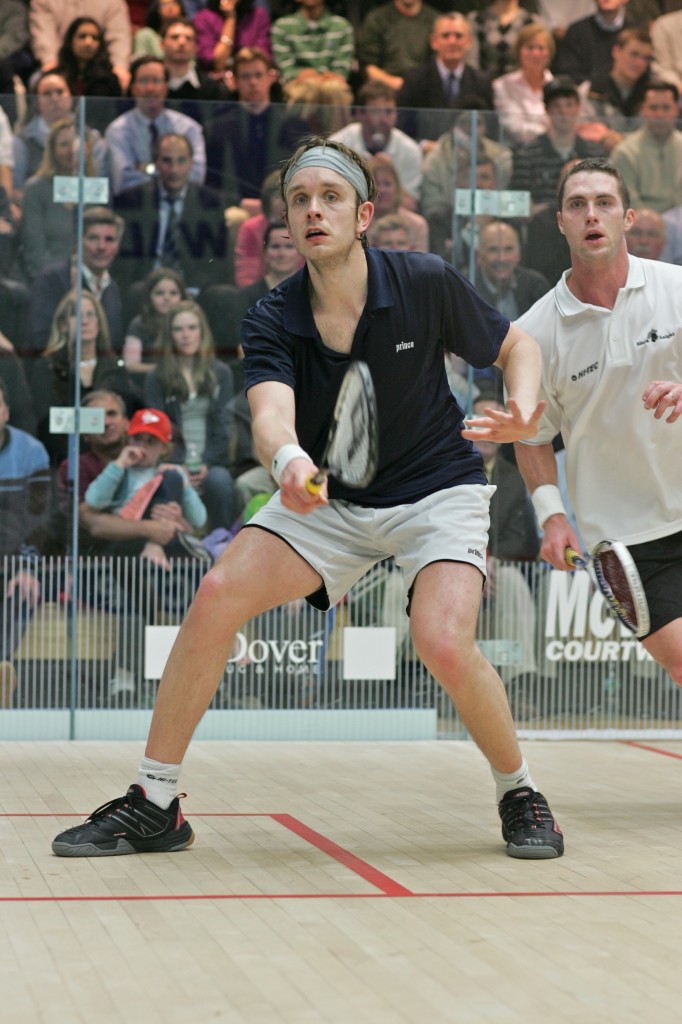
David Palmer was the hometown favorite, having moved two months before to Boston to work at the University Club. But he was not favored. He had bowed out of the PACE Canadian Classic because of lower back spasms that he had first developing while training at the University Club in early February. It might have been lugging too many boxes—he had also spent time moving his family into a house in Newton Centre. He then lost in the second round in Richmond. In the semis in Boston he had outlasted Thierry Lincou in a four-gamer (the 16-14 third game went for 37 minutes) but did not look sharp. He was still getting used to his new Black Knight racquets and feeling like he had not trained enough this winter.
Meanwhile Willstrop was brilliantly on form. Harvard’s all-glass court is called the Coaches Court and for the Players Cup final Willstrop put on a masterful clinic. His deception was marvelous and he repeatedly wrong-footed Palmer, especially with a flat forehand drive that started out looking like a crosscourt. He dictated the pace. He was patient and still purposeful. Palmer sometimes guessed correctly and was able to step up and volley but his shots were not particularly tight. “I didn’t feel like I could go too low,” he said after the match. “I wasn’t confident in my shooting.”
Willstrop bookended the match with 11-5 games, and the middle two went to tiebreakers. In the first overtime game, Willstrop let a 9-6 lead slip with a couple untimely tins. In the other, it crept up 8-all, 9-all, 10-all, 11-all, 12-all. With 25 grand more or less riding on the outcome of the game, the tension was tremendous. The players were stroppy, asking for lets, groaning and bemoaning. Once Willstrop served when Palmer wasn’t ready and Palmer flicked the ball back to him via the front wall with his left hand; Willstrop let the ball roll back to him. Palmer insouciantly then went to serve, telling the referee, in all seriousness, that he had not called for a let. It was a bit shabby.
At 12-all, Willstrop hit a fantastic drop to the front left corner, Palmer got to it stretched out and feebly hit a sitter that Willstrop put away. Collapsed in the corner, Palmer hurled his racquet to the back of the court, it whizzing perilously close to Willstrop—like Clemens & Piazza. The referee rightly awarded a conduct stroke to Willstrop for Palmer’s indiscretion, which gave Willstrop the game.
Millet guessed that if Willstrop went ahead in the fourth, Palmer would not be able to climb back and that is what happened, with a 3-0, 6-3, 8-5 skein that proved too much for a dispirited Palmer.
Upon exiting the court, the players retreated to their chairs in a side court. Near the left wall, Palmer’s 20-month-old daughter Kayla immediately perched on his knee, a true consolation. Across the court, Willstrop ate a banana and pondered what two matches of work had brought him. “Twenty-five grand—it is going to be nice to see it in the bank account, those numbers just sitting there,” Willstrop said.


